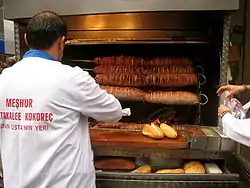Kokoretsi
Kokoretsi (Albanian: kukurec, Greek: κοκορέτσι, Turkish: kokoreç) is a dish of the Balkans and Asia Minor, consisting of lamb or goat intestines wrapped around seasoned offal, including sweetbreads, hearts, lungs, or kidneys, and typically grilled; a variant consists of chopped innards cooked on a griddle. The intestines of suckling lambs are preferred.
 Multiple rolls of kokoreç roasting on wood fire in İzmir, Turkey | |
| Type | Meat dish |
|---|---|
| Place of origin | Byzantine Empire Ottoman Empire |
| Region or state | Balkans, Asia Minor |
| Main ingredients | Lamb or goat intestines, offal (sweetbreads, hearts, lungs or kidneys) |
Etymology
According to Greek linguist and philologist Georgios Babiniotis, the Greek name kokoretsi comes from Albanian kukurec.[1][2] According to Turkish-Armenian linguist Sevan Nişanyan, Albanian kukurec is a loanword derived from Serbo-Croatian and Bulgarian kukuruza, originally meaning corncob in these languages. Nişanyan also asserts that Greek word is not derived from the Albanian kokërrëz, but both of the names are cognates and were loaned from Slavic languages.
Turkish word kokoreç comes from the word kokorótsi (κοκορότσι), which is used to describes the food in Albanian dialects of Modern Greek. It was first attested in "Lokanta Esrarı", a short story written in 1920 by the Turkish author Ömer Seyfettin.[3]
Preparation
The offal, along with some fat, is washed and cut into ½ to ¾-inch thick pieces, and lightly seasoned with lemon, olive oil, oregano, salt, pepper, and sometimes garlic. The intestine is turned inside out and carefully washed, then rubbed with salt and often soaked in vinegar or lemon juice and water.
The filling meats are threaded onto a long skewer and wrapped with the intestine to hold them together, forming a compact roll usually about 16–24 inches long by 1½–3 inches in diameter.
Kokoretsi is usually roasted on a horizontal skewer over a charcoal, gas, or electrical burner, and may be basted with lemon juice and olive oil.
A quite different preparation mixes the chopped innards with chopped tomatoes and green peppers, and then cooks them on a large griddle with hot red pepper and oregano added. The cook constantly mixes and chops the mixture using two spatulas. When done, the dish is kept warm aside on the griddle until someone orders a serving.
Serving
.jpg.webp)
The cooked kokoretsi is chopped or sliced, sprinkled with oregano, and served on a plate. Sometimes it is served on a piece of flatbread. Some add tomatoes or spices in it. It may also (especially in Turkey) be served in half a baguette or in a sandwich bun, plain or garnished, almost always with oregano and red pepper. In Turkey, common side dishes are pickled peppers or cucumbers. It is often seasoned with lemon, oregano, salt, a pepper, and typically accompanied by wine or raki.
National and regional variations
Greece
Kokoretsi is traditionally served for Orthodox Easter celebrations, when it is eaten while the lamb is roasting.[4] It is now also served year-round.[5]
Due to outbreak of mad cow disease in the late '90s, banning the consumption of offal was considered.[6] However, the idea was abandoned.
Gardouba (γαρδούμπα) or gardoubakia (γαρδουμπάκια) is a smaller variant of kokoretsi; it may be grilled like kokoretsi, or roasted in a pan. Its name comes from the Italian caldume.[2]
.jpg.webp)
Turkey
Kokoreç is one of the most consumed fast foods in Turkey,[7] being described as "the signature delight" of the country.[8] Although it is also served in some restaurants, most of the kokoreç is prepared, cooked and sold in small kiosks year-round, and is usually consumed as a sandwich after having alcohol. Kokoreç makers are called kokoreççi in Turkish.
In the early 2000s, during the Turkish accession to the European Union it has been speculated by the Turkish media that EU regulations regarding sheep's offal would eventually lead to a ban on kokoreç, if Turkey ever become a member state.[9][8]
See also
- List of goat dishes
- List of lamb dishes
- Torcinello, a similar southern Italian dish
References
- Georgios Babiniotis, Λεξικό της Νέας Ελληνικής Γλώσσας, s.v.
- Λεξικό της Κοινής Νεοελληνικής, s.v.
- "kokoreç". Nişanyan Sözlük. Retrieved 2020-02-24.
- Vilma Chantiles, Food of Greece: Cooking, Folkways, and Travel in the Mainland and Islands of Greece, 1992, ISBN 0671750968, p. 165
- Jonathan Deutsch, Natalya Murakhver, They Eat That?: A Cultural Encyclopedia of Weird and Exotic Food from Around the World, 2012, ISBN 0313380589, p. 125
- Michael Herzfeld, "The European Self", in Anthony Pagden, ed., The Idea of Europe, 2002, ISBN 0521791715, p. 162
- Ward, Lyn (2017-12-01). "Street Food: Kokoreç - a delicacy for offal lovers". Fethiye Times. Retrieved 2019-09-23.
- Thorne, John; Thorne, Matt Lewis (2008-11-25). Mouth Wide Open: A Cook and His Appetite. Farrar, Straus and Giroux. ISBN 978-1-4668-0646-7.
- "Kokoreç Almanya'da". Sabah (in Turkish). Retrieved 2020-03-11.
